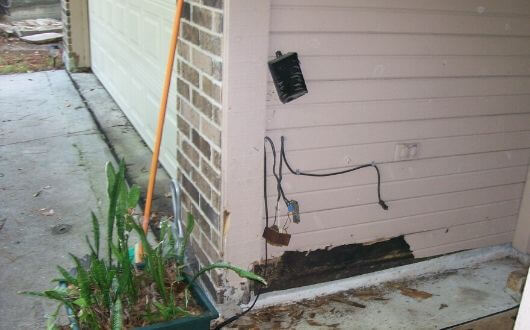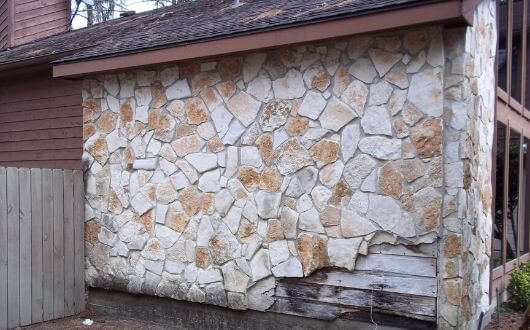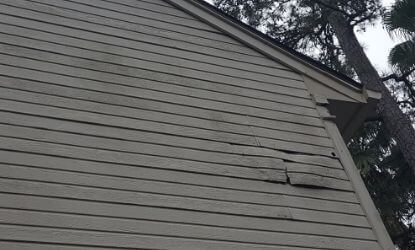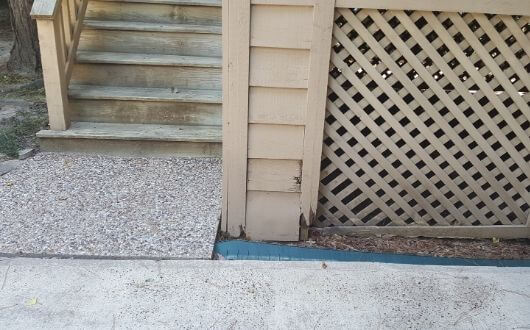Published November 27th, 2020 – Updated October 30th, 2023 | By Mike Monyak, Founder of Mr. Happy House

Your home’s exterior wood siding serves as both a protective barrier and a key element of its aesthetic appeal. However, over time, exposure to the elements, pests, and normal wear and tear can take a toll on wood siding’s ability to protect your home. Recognizing when it’s time to replace your exterior wood siding can prevent more extensive damage to your home and enhance its curb appeal.
In this article, we’ll dive into the top 6 signs that it is time to replace your exterior wood siding.
From visible decay and rot to the cost of ongoing maintenance, we’ll provide you with valuable insights to help you make an informed decision about the state of your siding.
If you’re a homeowner, understanding these signs will empower you to protect your investment and maintain the beauty and integrity of your home’s exterior.

When it comes to preserving the structural integrity and curb appeal of your home, the significance of exterior siding cannot be overstated. Your home’s exterior siding is more than just a simple decoration; it plays a pivotal role in safeguarding and enhancing its overall appeal. Let’s go into why having quality exterior siding is so essential:
One of the primary functions of exterior siding is to shield your home from the elements. It acts as a barrier against rain, snow, wind, and the harsh effects of sunlight. By preventing moisture from infiltrating your home’s structure, siding helps avoid issues such as rot, mold, and water damage.
Good exterior siding contributes to your home’s insulation. It assists in maintaining a consistent interior temperature, ensuring your living spaces remain comfortable throughout the year. Proper insulation not only enhances your comfort but can also lead to energy savings by reducing heating and cooling expenses.
The visual impact of your home is greatly influenced by the quality and condition of its exterior siding. Well-maintained siding can elevate your property’s curb appeal, making it more inviting and potentially increasing its resale value.

One of the most obvious signs that it’s time to replace your exterior wood siding is the presence of visible decay and rot. Wood is a natural material, and when exposed to moisture, it can begin to deteriorate over time. Here are some key indicators to watch for:
Check for discoloration and unsightly stains on your siding. Dark spots, patches of mold, or areas that appear wet or waterlogged can be signs of decay. These issues not only affect your home’s appearance but can also indicate structural problems.
Gently press on various areas of your siding with your finger or a tool. If the wood feels soft, spongy, or crumbles easily, it’s a strong indication of rot. This compromised wood won’t provide the protection your home needs.
Peeling or blistering paint or finish is another signal that your siding is suffering from moisture damage. When the paint no longer adheres properly, it can’t safeguard the wood beneath from further decay.
Fungus or mold growth on your siding is a clear sign of moisture-related issues. These organisms thrive in damp environments and can cause further deterioration if left unchecked.
When you observe any of these signs, it’s crucial to address the problem promptly to prevent further damage to your home’s structure. Depending on the extent of the decay, replacing the affected sections or the entire siding may be necessary. In the following sections, we’ll explore additional signs that should prompt you to consider siding replacement.
Peeling or blistering paint on your exterior wood siding is a noticeable and common issue that can signal the need for replacement. While it may seem like a purely aesthetic concern, it often indicates underlying problems that should not be ignored:
The paint or finish on your siding serves as a protective barrier against the elements, preventing moisture from infiltrating the wood. When the paint begins to peel or blister, this barrier is compromised, leaving your siding vulnerable to decay, rot, and other damage.
Peeling paint is a clear sign that moisture has infiltrated the wood beneath. Moisture can lead to structural issues, mold growth, and even compromise the insulation properties of your siding.
In addition to the practical concerns, the aesthetic appeal of your home can be greatly affected by peeling or blistering paint. It can make your property look unkempt and diminish its curb appeal.
Continuously repainting your siding to address peeling or blistering can become a significant maintenance chore and financial burden. Replacing the siding may offer a more cost-effective and long-term solution.
When you notice peeling or blistering paint on your exterior wood siding, it’s essential to investigate the extent of the damage and take appropriate action. Depending on the severity, this may involve repainting the affected areas or considering a complete siding replacement to restore both the protection and appearance of your home’s exterior.
Excessive moisture and the growth of mold on your exterior wood siding are clear indicators of a problem that should not be overlooked. Mold growth on your siding can lead to health issues and structural damage. Here’s what you should be aware of:
Mold and mildew growth often appear as dark or discolored spots on your siding. They may have a fuzzy or powdery texture and emit a musty odor. These growths can be both unsightly and unhealthy.
Excessive moisture can cause paint or finish to peel, discolor, or bubble on your siding. If you notice these issues along with mold growth, it’s a strong indication of moisture-related problems.
Mold and mildew can pose health risks, especially if you or your family members are sensitive to allergens. Addressing mold issues promptly is essential to maintain a healthy living environment. Mold can also spread into the interior of your home, so it’s important to not ignore mold growth.
Prolonged exposure to moisture can lead to structural compromises in your siding. It can weaken the wood, causing it to warp, rot, or decay. If left unattended, this can result in more extensive and costly repairs.
When you observe excessive moisture and mold growth on your exterior wood siding, it’s essential to take action. Identify the source of the moisture, address it, and consider replacing the affected siding to prevent further damage and maintain a safe and aesthetically pleasing home exterior.
Pest infestations on your exterior wood siding can be a serious issue that requires immediate attention. Insects and rodents can cause significant damage and compromise the integrity of your home. Here’s what to look out for:
Keep an eye out for visible signs of pest activity, such as holes, tunnels, or nests on or near your siding. Some pests, like termites or carpenter ants, can be particularly destructive to wood siding.
Certain pests, known as wood borers, tunnel into the wood, creating channels and weakening the structural integrity of your siding which can be very detrimental to your home’s structural integrity.
Rodents may find your siding an attractive place to build nests, which can lead to chewed or damaged wood. Their presence can also be a health concern and should be addressed promptly.
Preventing pest infestations through routine inspections and maintenance is crucial. If infestations are discovered, appropriate pest control measures should be taken. In some cases, replacing the affected siding may be necessary to ensure the pests are eradicated and further damage is prevented.
Recognizing and addressing pest infestations promptly can save you from costly repairs and maintain the structural integrity and appearance of your home’s exterior wood siding. In the following sections, we’ll explore more signs that indicate it might be time to replace your siding.

Warping, splitting, or cracking of your exterior wood siding is a clear indication that it may be time for a replacement. These physical deformities not only affect your home’s appearance but also compromise its functionality and protection. Here’s what to be aware of:
Warped siding appears bent or twisted, causing uneven surfaces. It can be a result of moisture absorption, excessive heat, or other environmental factors that affect the wood.
Splits or cracks in your siding can allow moisture to penetrate, leading to further damage and decay. They can also be a point of entry for pests, exacerbating the problem.
In addition to the structural concerns, these imperfections can significantly diminish your home’s curb appeal. Maintaining a well-maintained and aesthetically pleasing exterior is important for maintaining your home’s overall value.
When you notice warping, splitting, or cracking on your exterior wood siding, it’s advisable to assess the extent of the damage and determine whether repair or replacement is the best course of action which can be done by a professional siding company. Addressing these issues promptly can help maintain the integrity, appearance, and longevity of your home’s exterior.
High maintenance costs associated with your exterior wood siding can be a clear indication that replacement is a more cost-effective and practical solution. While routine maintenance is expected, excessive expenses can be a red flag. Here’s what you should consider:
If you find yourself repainting your siding more frequently than you would like, it’s a sign that your siding may not be holding up as it should. Frequent painting can become a costly and time-consuming task.
Constant repairs to address issues like decay, rot, or damage can accumulate in terms of both time and money. At some point, it may make more financial sense to invest in new siding.
As exterior wood siding ages, its maintenance requirements tend to increase. If your siding is reaching the end of its expected lifespan, the cost of upkeep may exceed the cost of a full replacement.
Old or deteriorating siding may lose its insulating properties, resulting in higher heating and cooling costs. Investing in new, energy-efficient siding can lead to long-term savings.
Considering the long-term financial implications of maintaining your siding is essential. If high maintenance costs are a recurring issue, it may be time to explore the benefits of replacing your siding with a more durable and cost-effective solution. This decision can ultimately enhance your home’s value and reduce ongoing expenses.

In this article, we’ve discussed the top six signs that indicate it’s time to replace your exterior wood siding. Your home’s siding is not only a visual focal point but also a critical protective barrier that plays a vital role in preserving your property’s integrity. Recognizing these signs and taking action when necessary can save you from costly repairs and maintain the aesthetics and functionality of your home’s exterior.
To recap, the key signs to watch for include:
If you’ve observed any of these signs, it’s essential to take action to address the problems promptly. Whether it involves repairing or replacing your exterior wood siding, making informed decisions will help ensure your home continues to provide the protection and aesthetic appeal you desire.
Regular inspections, routine maintenance, and investing in quality siding installed by a professional siding contractor like Mr. Happy House can extend the life and beauty of your home’s exterior. By staying vigilant and proactive, you can enjoy the benefits of a well-protected and visually appealing property for years to come.
We hoped you loved this article on the tops signs it's time to replace exterior wood siding, please share and tune in for more roofing, siding, and house painting content!
Our Services:












Schedule a Free Estimate Today!












One Response
It’s good to know that you should get new siding if it’s cracked or chipped. My husband and I have noticed a couple of weeks ago that our siding has started to have some issues with chipping, and we were wondering if that was a bad sign. We’ll have to look into hiring a contractor that can come and install new siding for our home as soon as possible!